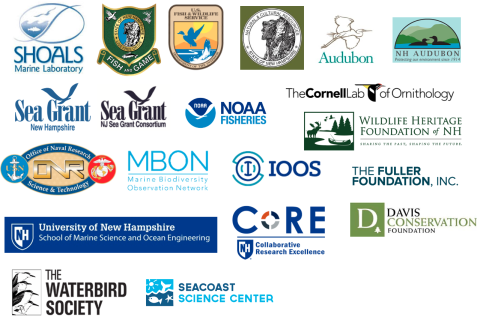Isles of Shoals Seabird Ecology and Conservation Program
PI: Dr. Elizabeth Craig (Director of Seabird Research, Shoals Marine Laboratory, UNH)
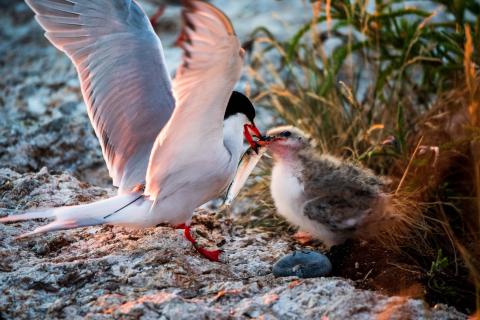
The Isles of Shoals Seabird Ecology and Conservation Program promotes the conservation of aquatic birds in the Gulf of Maine through monitoring, management, and student-driven research. As top predators in marine systems, seabirds are sentinels of marine ecosystem function and ocean health. They are threatened by environmental contamination, coastal habitat destruction, overharvesting of resources, and climate change. Our team applies insights from seabird ecology to identify conservation challenges and guide management action in the context of a changing ocean.
Focal species include terns, gulls, guillemots, cormorants, and long-legged wading birds (herons, egrets, and ibis).
Opportunities to participate in this research program:
Seabirds Ecology & Conservation undergraduate research internships
Seasonal Seabird Technician positions
SML Academic Programs
|
Research Topics |
Presentation and Publication Highlights |
Climate Change Impacts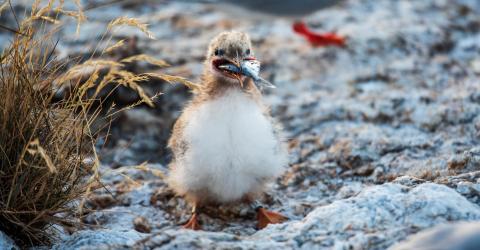
|
**Smith, O. and E. Craig. 2020. Effects of climate-mediated changes in the diet of a threatened Gulf of Maine seabird. Waterbird Society Virtual Meeting. Special Student Paper Recognition. |
Seabird Diet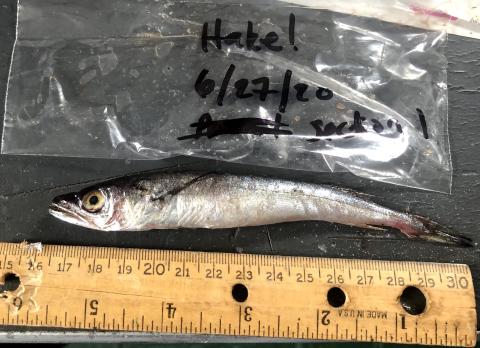
|
**Yang, A., **N. Milsky, G. Clucas, and E. Craig. 2023. Chick diet composition and feeding frequency of black guillemots (Cepphus grylle) on Appledore Island. Regional Association for Research on the Gulf of Maine Annual Science Meeting. Clucas, G., A. Stillman, and E. Craig. 2023. From presence/absence to reliable prey proportions: A field test of fecal metabarcoding for characterizing seabird diets. The Waterbird Society annual meeting. Fort Lauderdale, FL. Craig, E., M. Staudinger, M. Rubega, G. Clucas, C. Mostello, J. Walsh, and T. Wilson. 2021. Pilot monitoring of roseate tern foraging ecology: Lessons learned. Roseate Tern Recovery Team virtual meeting. Clucas, G., E. Craig, D. Lyons, L. Welch, P. Shannon, A. Kovach, S. Kress, and J. Seavey. 2021. Quick and dirty -- but really useful! Monitoring seabird diets from faecal samples in the Gulf of Maine. Virtual World Seabird Conference. Craig, E., A. Kovach, J. Seavey, and G. Clucas. 2018. Evaluating interspecific and age-based variation in the diet and foraging behavior of common and roseate terns breeding on the Isles of Shoals, NH. Waterbirds Society Meeting, Princess Anne, MD. Craig, E., A. Kovach, J. Seavey, and G. Clucas. 2018. The upside to getting pooped on by terns – A fecal DNA analysis of tern diet on the Isles of Shoals, NH. Waterbird Society Meeting. Vancouver, BC, Canada. |
Contaminants and Health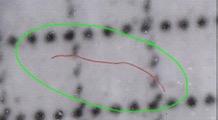
|
**Gritton, R., G. Clucas, E. Craig, and B. Trevelline. A preliminary characterization of the gut microbiome of Common and Roseate terns on Isles of Shoals, NH, USA. American Ornithological Society Conference. Estes Park, CO. Dalton, E., L. Sette, and E. Craig. 2022. Using double-crested cormorant (Nannopterum auritum) colonies to pilot two methods for monitoring environmental health. Association of Field Ornithologists annual meeting, Plymouth, MA. **McDowell, O., **C. Wardinski, **M. Cheng, *A. Caldwell, B. Brown, and E. Craig. 2021. Evaluating regurgitated pellets as indicators of microplastic ingestion by NH-breeding seabirds. Poster presentation for Virtual UNH Undergraduate Research Conference. Student poster award. **Caldwell, A, J. Seavey, and E. Craig. 2018. Plastic consumption in seabirds on the Isles of Shoals. Poster presentation for the Regional Association for Research on the Gulf of Maine. Portland, ME. |
Seabirds as Fisheries Indicators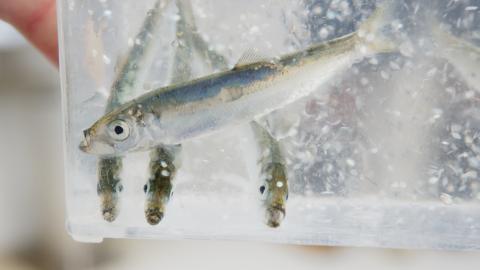
|
Craig, E., J. Seavey, *A. Caldwell, *N. Hermann, and N. Furey. 2023. Seabirds as indicators of New Hampshire’s fisheries. NH Sea Grant Research Symposium, Durham, NH. *Caldwell, A., N. Furey, J. Seavey, *N. Hermann, and E. Craig. 2020. Assessing the use of terns as forage fish population monitors in the Gulf of Maine. Roseate Tern Recovery Virtual Meeting. |
Movement - Foraging and Migration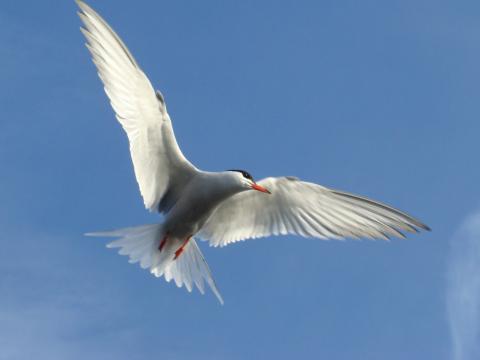
|
*Caldwell, A., E. Craig, *N. Hermann, and N. Furey. 2023. Spatiotemporal variation in common tern foraging movements. UNH School of Marine Science and Ocean Engineering Graduate Research Symposium, Durham, NH. Best poster award. *Caldwell, A., E. Craig, and N. Furey. 2022. common tern (Sterna hirundo) foraging movement: characterizing interannual and intraspecific variations. Waterbird Society meeting, Corpus Christi, TX. Welch, L., E. Craig, and P. Loring. 2019. Using GPS loggers to track Arctic and common terns in the Gulf of Maine. Waterbirds Society Meeting, Princess Anne, MD. Craig, E. and P. Curtis. 2016. A continental divide in migratory behavior: Conservation implications for the common tern. Poster presentation for the Waterbird Society Meeting. New Bern, NC. |
Parental Behavior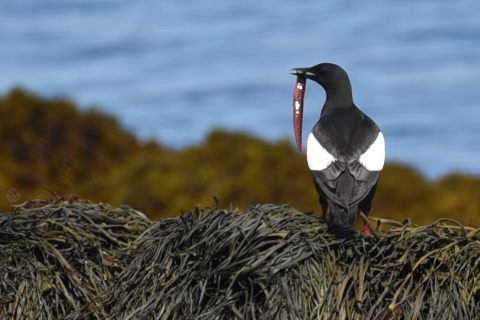
|
**Duca, A., *A. Caldwell, and E. Craig. 2023. Food availability impacts aggression in common terns (Sterna hirundo) at a Gulf of Maine breeding colony. UNH COLSA Undergraduate Research Conference. Durham, NH. **Dalehite, W., **Y. Park, G. Clucas, and E. Craig. 2022. Parental investment in black guillemots (Cepphus grylle) on the Isles of Shoals. Waterbird Society meeting, Corpus Christi, TX. |
Nest Site Selection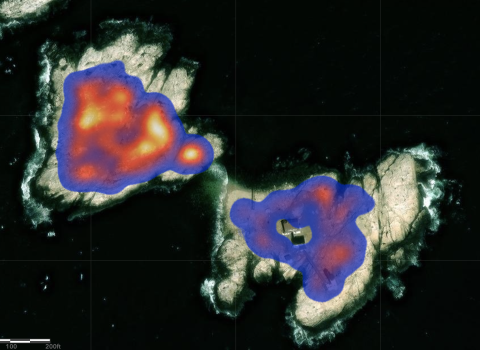
|
**Park, Y., **W. Dalehite, G. Clucas, and E. Craig. 2022. Nest site selection and breeding success in black guillemots (Cepphus grylle). SML Undergradauate Research Symposium, Appledore Island, ME. **Fugle, C. 2022. Variation in roseate tern productivity across Seavey Island. SML Undergraduate Research Symposium, Appledore Island, ME. |
Investigator Disturbance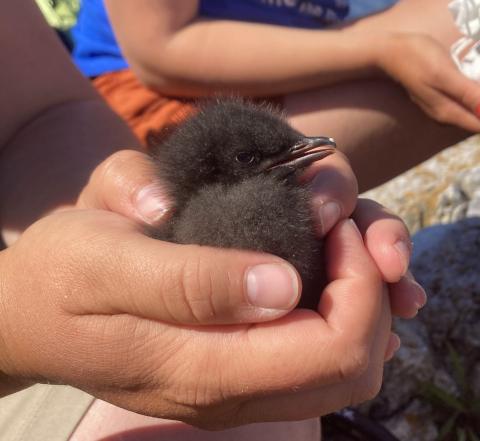
|
**Guo, C., G. Clucas, and E. Craig. 2024. GPS tag attachment does not constrain parental behavior of Roseate Terns (Sterna dougallii). American Ornithological Society Conference. Estes Park, CO. **Kupferberg, E., **K. Galvin, *A. Caldwell, and E. Craig. 2024. Tag, you’re it: Investigating impacts of GPS tagging on common terns (Sterna hirundo). UNH COLSA Undergraduate Research Conference. Durham, NH. **Milsky, N., **A. Yang, G. Clucas, and E. Craig. 2023. Assessing the impacts of investigator disturbance on the breeding success of black guillemots (Cepphus grylle). Regional Association for Research on the Gulf of Maine Annual Science Meeting. |
Adaptive Habitat Management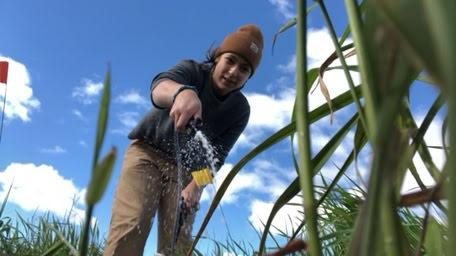
|
|
Population Monitoring and Conservation Management Our program contributes to long-term population monitoring and conservation management of key aquatic bird populations on the Isles of Shoals, including terns, Alcids, long-legged wading birds, cormorants, and more. |
Isles of Shoals Tern Conservation Project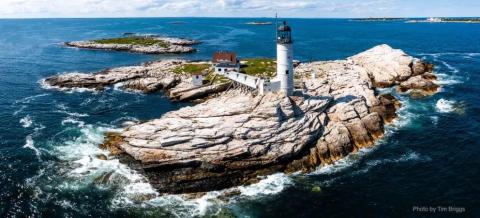
Opportunities to participate: Seasonal Seabird Technician positions and SML Academic Programs. |
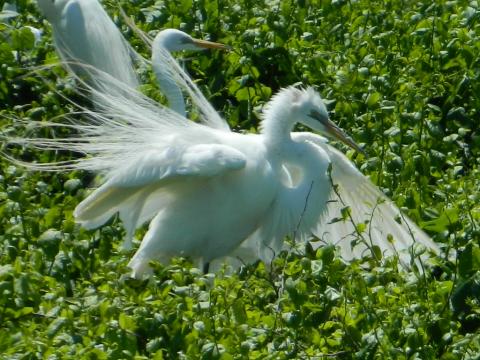
Wading Birds of Appledore Island
During the spring and summer you can view the breeding colony live. |
Alcids on the Isles of Shoals
The Isles of Shoals is the southernmost breeding location of Alcids (typically Arctic breeding seabirds) along the Atlantic Coast. As such, monitoring and researching Alcids breeding on the Isles of Shoals (including their abundance, reproductive success, diet, and behavior) provides critical insight into how cold-adapted species fare in rapidly warming Gulf of Maine waters. The Seabird Ecology and Conservation Program began concerted research and monitoring efforts of black guillemots, our focal Alcid species, in 2017. |
Seabird Ecology and Conservation Program Team |
Director, Seabird Ecology and Conservation Program
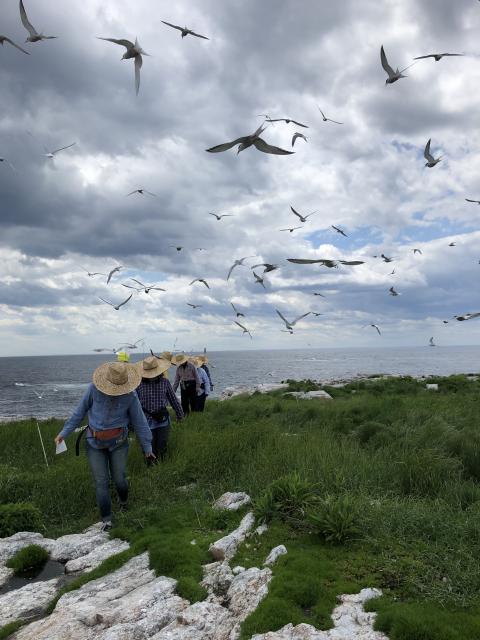
Elizabeth Craig, Shoals Marine Laboratory
Research and Conservation Partners
- Celia Chen, Dartmouth College
- Gemma Clucas, Cornell Lab of Ornithology
- Nathan Furey, University of New Hampshire
- Natasha Gownaris, Gettysburg College
- Laura Kloepper, University of New Hampshire
- Kimberly Lato, University of New Hampshire
- Pam Loring, US Fish and Wildlife Service
- Don Lyons, National Audubon Society and Oregon State University
- Michael Marchand, NH Fish and Game Department
- Gregg Moore, University of New Hampshire
- Alexis Mychajliw, Middlebury College
- Mike Palace, University of New Hampshire
- Lisa Sette, Center for Coastal Studies
- Michelle Staudinger, University of Maine
- Frankie Sullivan, University of New Hampshire
- Linda Welch, US Fish and Wildlife Service
Learn about our friends at the Gulls of Appledore
Students and Research Interns
- Aliya Caldwell, UNH, current graduate researcher (Furey Lab) and 2018 SML undergraduate research intern
- Valerie Eddington, UNH, current graduate researcher (Kloepper lab)
- Nate Hermann, UNH, current graduate researcher (Furey lab)
- Keenan Yakola, Oregon State University, current graduate researcher (Lyons Lab)
- Ben Kerstetter, Cornell University, 2025 SML undergraduate research intern
- Caitlin Panicker, Bowdoin College, 2025 SML undergraduate research intern
- DeAnna Pitcher, UNH, 2024 undergraduate research student
- Grace Guo, Cornell University, 2024 SML undergraduate research intern
- Kati Leitner, UC Santra Cruz, 2024 SML undergraduate research intern
- Elizabeth Kupferberg, UNH, 2024 undergraduate research student
- Kaylee Galvin, UNH, 2024 undergraduate research student
- Dan Zogby, UNH, 2024 undergraduate research student (Kloepper lab)
- Abbey Yang, Cornell University, 2023 SML undergraduate research intern
- Noah Milsky, Colby College, 2023 SML undergraduate research intern
- Joe Brosseau, UNH, 2023 undergraduate research student (Kloepper lab)
- Amelia Duca, UNH, 2023 undergraduate research student
- Patrick Gritton, Cornell University, 2023 undergraduate research student (Cornell Lab of Ornithology)
- Willow Dalehite, Princeton University, 2022 SML undergraduate research intern
- Yuna Park, Cornell University, 2022 SML undergraduate research intern
- Chloe Fugle, Dartmouth College, 2022 SML undergraduate research intern
- Lenny Laird, Dartmouth College, 2022, SML undergraduate research intern
- Ry Andruk, UNH, 2022 undergraduate research student
- Max Miller, Cornell University, 2021-2022 undergraduate work study (Cornell Lab of Ornithology)
- Matt Cheng, UNH, 2021 undergraduate research student
- Lauren McDowell, UNH, 2021 undergraduate research student
- Cate Wardinsky, UNH, 2021 undergraduate research student
- Olivia Smith, UNH, 2019 undergraduate research student and 2020 SML undergraduate research intern
Seabird Technicians
- Kayla Cannon, 2025
- Joe Brosseau, 2024-2025
- Hope Caliendo, 2024
- Willow Dalehite, 2023
- Orena Wong, 2023
- Theresa Rizza, 2022
- Olivia Smith, 2021-2022
- Beckley Stearns, 2020-2021
- Aliya Caldwell, 2019-2020
- Amber Litterer, 2018-2019
- Caitlin Bowman, 2018
- Taylor Ouelette, 2017
- Elizabeth Ford, 2016-2017
- Abbey Cramer, 2016
|
Featured by |
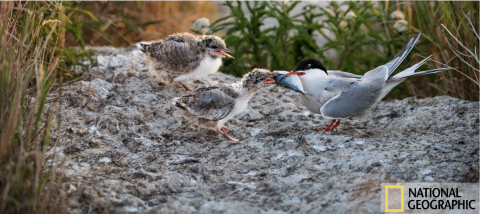
|
|
Support and Funding for the Seabird Ecology and Conservation Program |
